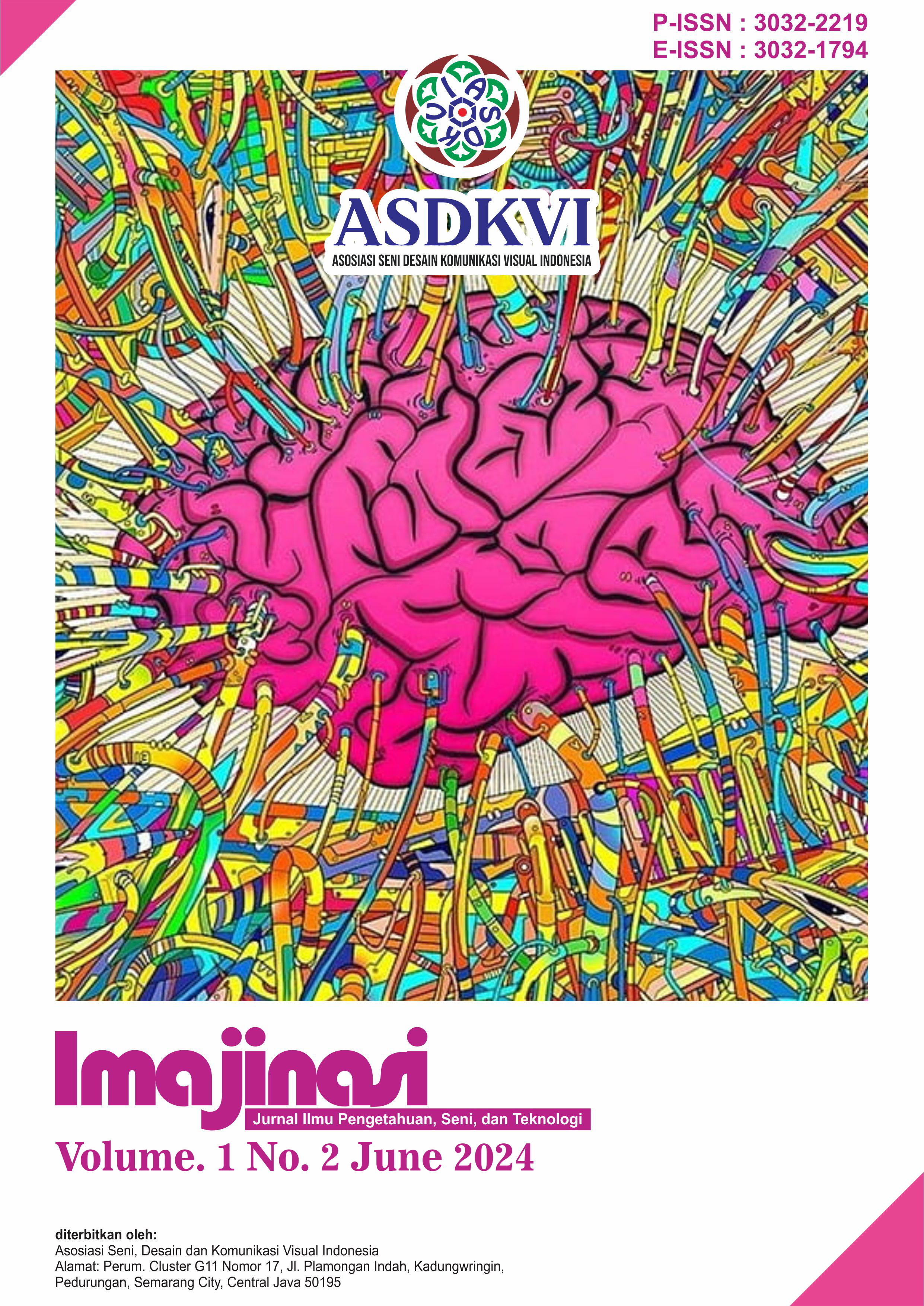Struktur Gerak Tari Sayak di Desa Air Batu Kecamatan Ranah Pemberap Kabupaten Merangin Provinsi Jambi
DOI:
https://doi.org/10.62383/imajinasi.v1i2.157Keywords:
Structure, Motion, DanceAbstract
The purpose of this study is to explain and describe the movement structure of Sayak Dance in Air Batu Village, Ranah Pemberap District, Merangin Regency, Jambi Province. This type of research is qualitative research with descriptive methods. Research instruments are researchers themselves and assisted by supporting instruments such as stationery and cameras. Data was collected through observation, interviews, and documentation. The steps of analyzing data are data collection, data reduction, data presentation and conclusions. The results showed that the relationship of basic elements, Sayak Dance has basic elements related to the attitude of the movement of body parts, starting from the head, body, hands, feet. The attitudes and movements contained in the Sayak Dance consist of: 1) attitudes and movements seen in a) the attitude of the head is upright, upright motion on the head does not exist. 2) Posture and gestures are seen in: a) upright, upright and leaning forward posture b) Motion on the body is absent 3) Posture and hand gestures are seen in: a) attitude on the hand lift sambah b) motion on the hand open straight sambah, open right sambah, pat me up, pat the right side of the leaf, pat the bottom slap, pat the back 4) attitude and motion on the feet seen in: a) attitude of the right foot, squat, middle stance, right lift, lift left, and bend. The grammatical hierarchical relationship system contained in Sayak Dance consists of 15 motifs, 8 phrases, 4 sentences and 1 cluster. Sayak dance includes syntagmatic relationships, relationships that are like links that cannot be separated or exchanged between the sati and others.
References
Armi, R. F., & Mansyur, H. (2022). Bentuk Penyajian Tari Hari Langsung Sebagai Tari Kreasi Masyarakat Kota Pekanbaru. Jurnal Sendratasik, 11(2), 219-226.
Bogdan, & Taylor. (2012). Prosedur Penelitian. Jakarta: Rineka Cipta.
Daryusti. (2006). Hegemoni Penghulu dalam Perspektif Budaya. Yogyakarta: Pustaka.
Indrayuda. (2013). Tari Sebagai Budaya dan Pengtahuan. UNP Press Padang.
Maibur, L. P., & Mansyur, H. (2022). Analisis Gerak Tari Piriang Rantak Kudo di Pauh IX Lapau Munggu Kecamatan Kuranji Kota Padang. Jurnal Sendratasik, 11(3), 467-475.
Nerosti, N. (2019). Nilai-Nilai Kearifan Lokal Melalui Tari Galombang Gaya Sasaran: Studi Sasaran Sebagai Sarana Pendidikan Kultural. Dance and Theatre Review, 2(1).
Saputra, M. J., & Hamdi, N. (2019). Rancang Bangun Aplikasi Sejarah Kebudayaan Aceh Berbasis Android Studi Kasus Dinas Kebudayaan Dan Pariwisata Aceh. Journal of Informatics and Computer Science, 5(2), 147-157.
Sari, T. R., & Mansyur, H. (2020). Koreografi Tari Piring Hoyak Badarai Di Sanggar Sarai Sarumpun Di Kota Padang. Jurnal Sendratasik, 9(2), 10-16.
Suharto, Ben. (1983). Tari Analisis Bentuk Gaya dan Isi sebagai Penunjang Proses Kreatif. Makalah pada acara produksi bentuk budaya Jogjakarta.
Sumaryono. (2011). Antropologi Tari Dalam Perspektif Indonesia. Yogyakarta: Badan Penerbit ISI Yogyakarta.
Triagnesti, S., & Mansyur, H. (2021). Bentuk Penyajian Tari Pisau Dua Pada Acara Bimbang Adat Di Desa Sendawar Bengkulu. Jurnal Sendratasik, 10(3), 80-89.
Downloads
Published
How to Cite
Issue
Section
License
Copyright (c) 2024 Imajinasi : Jurnal Ilmu Pengetahuan, Seni, dan Teknologi

This work is licensed under a Creative Commons Attribution-ShareAlike 4.0 International License.





